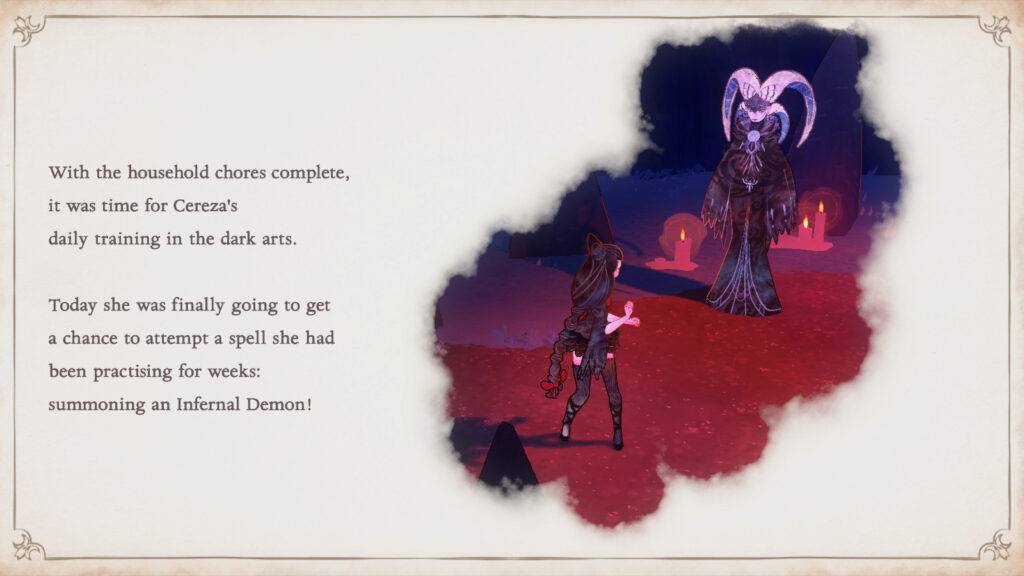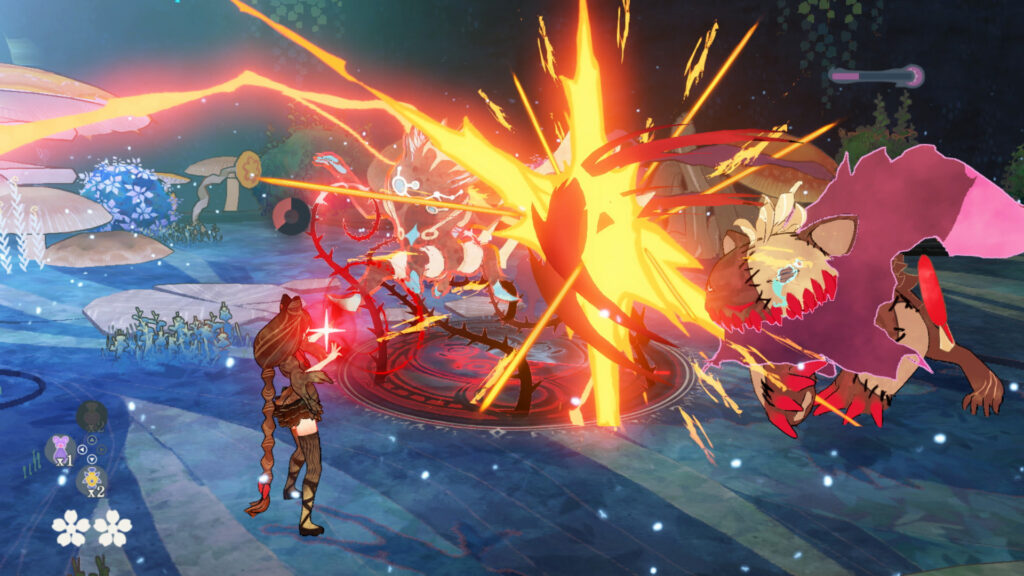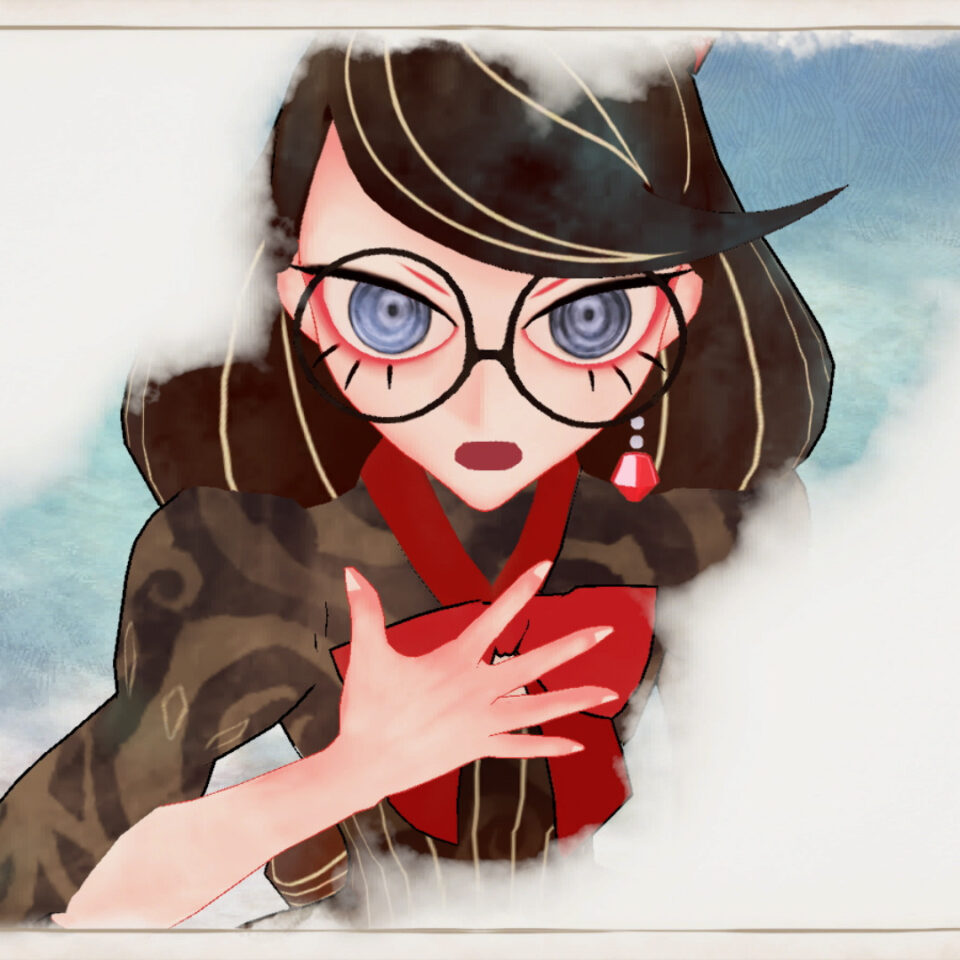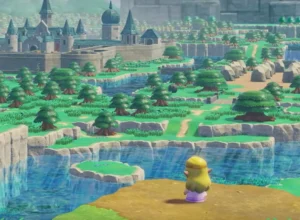Bayonetta games are a bit like (infernal demon) trains: You wait eight years for one, then two arrive in the space of six months.
Bayonetta begins with a shot of the moon. It has drawn impossibly close and fills the frame, as though looming in for an Earthly kiss. It’s draped in sepia, giving it the tint of good cheese, and the screen crackles like old film. We read the words “In a universe of light and dark, where perception is reality,” and we wonder what the hell is going on. Seconds later, we see our heroine standing on a plummeting chunk of church, beset by winged beasts, and we realise that what’s going on is probably Hell. It isn’t long before a narrator tells us about the world, but the exposition is mingled with the rush and vertigo of the scene. We aren’t sure, amid the crazed angles, of where our attention should lie. Reality and perception are locked in battle.
Compare the opening of Bayonetta Origins: Cereza and the Lost Demon, a new prequel from developer PlatinumGames. We get the same old story, all about the long-running tiff between light and dark, this time relayed calmly, in a crisp Scottish burr, and bound in the lazy pages of a book. The same woman that would one day be riding hurtling rubble and firing pistols at flocks of demons is, here, getting bullied at school. Woe betide the bullies. Bayonetta, or Cereza, as she was known in her childhood, is an outcast. She is the product of forbidden love. Her parents, belonging to opposing clans – her father a Lumen Sage and her mother an Umbra Witch – have denied her an easy upbringing. They were star-crossed and she is stir crazy.
She stays and studies with Morgana, who is something of an old goat. I say this not just because she is a stern elder witch, reinforced against fun, but because her hair, which is the hue of sour milk, is plaited into curved horns that arc down her back. Maybe a mountain would cheer her up. What strikes you about these early moments is the look and the tempo of the thing. The cutscenes unfold on slightly foxed parchment, with wild colours that drip and bloom; while play is more vivid still, all swashes of cooling indigo and reds that bleed and burn. It looks as though Cereza had stumbled into a stained-glass window. Perhaps that’s exactly the effect that the art director, Tomoko Nishii, wanted: casting a vibrant light on an old legend, reminding us that paper and glass are merely brittle vessels for the transmission of enduring tales. Whatever the perception, reality shines through.

Cereza’s days have a Disney rhythm – the youthful yearning for adventure; the craving to grow up fast; and the stepmotherish figure, hands pinned to her hips, glaring as the girl fetches pails of water. These early chapters are slow, and you feel the itch of impatience, in solidarity with Cereza, as you run back and forth doing her chores, waiting for the narrative to spring a leap. Eventually, it does. After trying and failing to control a summoned demon, under Morgana’s frowning tutelage, Cereza sneaks out by night and goes to the nearby Avalon Forest. Heeding a voice that crooned in her dreams, telling her to find a white wolf, she is on the hunt for power – the better to aid a rescue of her real mother, who was imprisoned for her crimes of passion.
Cereza discovers that the demon she attempted to raise has hung around. As players of the previous Bayonetta games will know, witches conjure demons via the medium of their hair; the creatures are plucked from a plane called Inferno and conditioned, as it were, to obey. In lieu of hair, this particular brute has settled for the felt of Cereza’s plush toy cat, Cheshire (the only memento she has from her mother). Thus equipped, she may just be able to handle the perils of the wood, bristling, as it is, with faeries. These are not flighty sprites but vicious little tricksters, bent on kidnapping stray children and sapping their souls. Combat has you controlling Cheshire with the right stick and Cereza with the left. She can ensnare foes in an infernal briar; he, swelling to the size of a lion, can knock the stuffing out of them with claws and teeth.
The echo is of Brothers: A Tale of Two Sons, which has us guiding a pair of siblings through the wreckage of a fairytale. They, too, are out to aid a languishing parent, and the developer, Starbreeze Studios, throws up puzzles and uses the dual-stick scheme to probe their fraternal bond – the way they click and drift and snap back together. PlatinumGames, as ever, is more interested in the chop and surge of combat, which becomes its own sort of brain-busting puzzle, as you dodge incoming projectiles with Cereza and pounce with Cheshire.

The clashes aren’t stirred with the same intense and punishing concoction that holds sway in the game’s grown-up predecessors, but they do have a pleasing, vitreous punch. Enemies burst into shards, and cracks hang in the air. Fights are viewed from on high, in an isometric angle, as if the camera were wedged in the forest canopy; this affords a clean view of each bout and gives us an airy vantage on the world. Note the layering of Celtic folklore: Cereza plunges into pockets of distortion called Tír na nÓg, the “Land of the Young,” in which she rescues Wisps, the spirits of lost children.
Hideki Kamiya is credited as the “original story & chief scenario writer,” and I wasn’t in the least bit surprised by the presence of Lewis Carroll here. There is Cheshire, of course, with his grin intact. Not only is Cereza following a white wolf, but we get a colony of white rabbits to jam the point home, plus a Jabberwock, which comes whiffling through the tulgey wood in the form of a boss fight. Kamiya has always been enamoured of Carroll’s work, littering his games with nods and winks. Hence the Red Queen, Nero’s sword of choice in Devil May Cry 4; the chess pieces that slot into the sewer puzzle in Resident Evil 2; and the Ecliptic Express, from Resident Evil 0, which shuttles you into a nightmare, like the locomotive in Through the Looking-Glass, and What Alice Found There.
With Carroll, it’s a short hop from the dreamy to the drugged (a connection famously stoked by Jefferson Airplane), and it’s enticing to imagine Cereza and the Lost Demon as an extended riff on being under the influence. As you craft potions to aid in battle, watch Cereza toss the ingredients into a cauldron and cook up a gloopy storm. And look as Cheshire, as he gains elemental powers, coating himself in a carpet of wet green and lashing a tongue of vines. You use these in traversal – pulling platforms for Cereza to stand on, or spewing out pillars of water to jet the pair of you across a lake. But it’s equally fun to view his kaleidoscopic transformations as a pure trip.

How better to explain the way that such grim subject matter seems to melt away, in a kind of morning air, once you’ve stopped playing? Check out the Wisp (the ghost of a kid, remember) who has a nail driven through its head. Kamiya recognises the need for real nastiness that spikes a good fairytale, but, unlike Starbreeze, he doesn’t go for sentiment or saturate the journey with tears. True, at one point Cereza cries for her mummy, but the moment is soon shrugged off, with no lingering poignancy; and nor do you long for Cereza and Cheshire to be stitched together by anything more than circumstance. As Morgana warns her, “Demons are weapons which we witches wield, not friends to be cuddled.” Translation: No fuzzy feelings, thanks.
So, what does propel this arresting and skittish game? In a word, Bayonetta. Or, rather, the chance to see Kamiya ponder the starting point of one of gaming’s stranger heroines. “I’m going to be strong too! But I’m going to do it with style,” she says, foreshadowing the chic blend of monster-slaying yet to come. Voiced by Angeli Wall, Cereza is precocious, given to fits of giggling, and resonantly good – keen to pitch in and help because it’s right. There is nothing of the dry and languid wit that blossoms with age, as her innocence withers. You can’t quite imagine her donning leather and heels and pointing a brace of pistols at the screen, though you can maybe see where Kamiya is plotting a course. With its focus on matriarchs – good and bad, absent and present – we should praise Platinum for resisting the temptation to call it Mothers: A Tale of Two Guns. This is a game that beckons our attention equally to the here and now, whether reality or merely perception. She is strong, and she does it with style.
Game: Bayonetta Origins: Cereza and the Lost Demon
Platform: Nintendo Switch
Developer: Platinum Games
Publisher: Nintendo
Release Date: March 8, 2023






